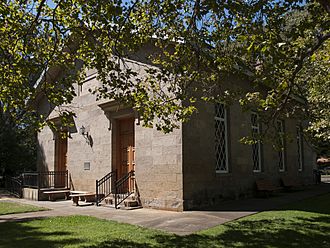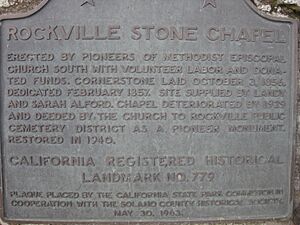Rockville Stone Chapel facts for kids
Quick facts for kids Rockville Stone Chapel |
|
|---|---|

The Rockville Stone Chapel in 2019
|
|
| General information | |
| Location | Rockville Cemetery, Suisun Valley Rd, 0.2 mi N of Rockville |
| Town or city | Rockville, Solano County, California |
| Coordinates | 38°14′51″N 122°07′18″W / 38.24746°N 122.12176°W |
| Designations | Registered as California Historical Landmark #779, Nov. 20, 1962 |
The Rockville Stone Chapel is a historic church building in California. It was built in the fall of 1856 and first used for Christmas services that same year. The chapel was officially opened in February 1857.
Over time, the church faced challenges, including disagreements among its members. By 1929, the building was in poor condition. It was then given to Solano County. After a big renovation in 1940, the chapel was saved. It was named a State Historical Landmark in 1962. Today, the chapel is still used for church services, weddings, and funerals.
Contents
Building the Chapel: A Community Effort
How the Idea Started
In the early 1850s, the Suisun Valley was a popular spot for "camp meetings." These were outdoor church gatherings held by the Methodist Episcopal Church. Families would camp out for up to two weeks. They even brought their cows for fresh milk!
At a meeting in 1855, church leaders suggested building a permanent church. They raised $5,000 to help pay for it. A local resident named Landy Alford donated the land for the chapel and a nearby cemetery.
Construction Begins
The chapel was built in the fall of 1856. The stone used for the building came from nearby hills. This special stone, made of volcanic ash and magnesium, was soft and easy to cut. But it became hard soon after being exposed to air. Most of the workers were volunteers. They were led by skilled stonemasons Joel Price and George Whitely.
The first stone was laid on October 3, 1856. Construction moved quickly. Christmas services were held in the new chapel that year. The church was officially opened in February 1857.
Challenges and Decline
A Split in the Church
Soon after the chapel was built, its members disagreed about slavery. At the Christmas Eve service in 1863, the members who supported the Northern side left. The remaining members, who supported the Southern side, put a plaque on the chapel. It is still there today and reads: "M.D. Church South - 1858."
Falling Apart
After the Civil War ended, fewer and fewer people attended the chapel. The last full-time minister left in 1895. Services continued sometimes, but the building slowly fell apart. Windows broke, and the roof leaked. The leaks caused the wooden floors to rot.
In 1906, after the big San Francisco Earthquake, one funeral was held outside. People were worried the chapel might collapse from aftershocks.
Bringing the Chapel Back to Life
A Gift to the County
In 1929, the chapel was given to Solano County. It was meant to be a memorial to the pioneers who settled the area. There were rules for the county to follow. They had to keep the chapel in good condition. It could not be used for non-religious events. Also, the 1863 plaque had to stay. If any of these rules were broken, the chapel would go back to the church.
The Great Depression and Renovation
The Great Depression started in 1929. This meant there was no money for repairs for many years. Finally, in 1940, local residents worked together to get help. They convinced the WPA (Work Projects Administration) to take on the project. The WPA was a government program that created jobs during the Depression.
Workers from a state camp helped fix the chapel. They put on a new roof and replaced the old, low ceiling. The walls were replastered, and new stained-glass windows were installed. A new floor was also put in. The 22 original church benches were repaired.
Rededication and Landmark Status
The chapel was officially reopened on Memorial Day in 1940. In 1962, the Solano Historical Society worked to get the chapel recognized as a state landmark. It was listed as State Historical Landmark #779 in October of that year.
The Chapel Today
The Rockville Stone Chapel is still an active place of worship. As of 2025, it serves as the main church for the local Church of Christ. It is also a popular place for weddings and funerals.
Around 2007, the chapel had more renovations. The windows were replaced again. The floor was sanded and shined. The old church benches were replaced with slightly larger ones. This was because people today are generally taller than people were 150 years ago!
There are two special plaques outside the chapel. One is the official State Historical Landmark plaque. It tells about the chapel's history and its restoration. The other plaque was placed by the WPA after their work in 1940.
The chapel has been described as "A tiny rock-walled church among great brooding trees that spread green arms around it and raise still heads above it as though in wordless prayer.”
See also


